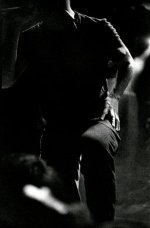x-ray
Veteran
Looking at your scans you're probably 3-4 stops under exposed.
Delete the phone app, they're terrible. Other than the bad app your biggest problem you don't understand how to use a meter. If you don't understand metering a spot meter will only get you in more trouble. Stop and learn to walk before you try to run.
These aren't easy situations even for even those of us that have decades of experience. First I'd never use a phone app. I'd use a very sensitive meter with a narrow angle of view like my Weston ranger 9 or use a very sensitive broad angle meter and tilt it down some and even use my hand to shield some of the backlight off the meter being careful not to block any part of what the meter is reading. Actually as close as you were an incident meter would possibly work. Third I'd never go into something with an uncoated lens. You're going to get terrible flare when spotlights hit the lens. Next I'd pick HP-5 and use Acufine because it actually increases ISO. Acufine is about the only developer left that increases shadow speed. I like the results better than Delta 3200.
You might not like hand held meters or your meter but depending on the meter and how well you know how to use it it's the only way to get correct exposures in tough situations. The light in the kind of situation is constantly changing so the reading you make will be wrong in 5 seconds. Also "experience" goes a long way when things are tough. Continue going this route and you'll continue getting bad images.
Delete the phone app, they're terrible. Other than the bad app your biggest problem you don't understand how to use a meter. If you don't understand metering a spot meter will only get you in more trouble. Stop and learn to walk before you try to run.
These aren't easy situations even for even those of us that have decades of experience. First I'd never use a phone app. I'd use a very sensitive meter with a narrow angle of view like my Weston ranger 9 or use a very sensitive broad angle meter and tilt it down some and even use my hand to shield some of the backlight off the meter being careful not to block any part of what the meter is reading. Actually as close as you were an incident meter would possibly work. Third I'd never go into something with an uncoated lens. You're going to get terrible flare when spotlights hit the lens. Next I'd pick HP-5 and use Acufine because it actually increases ISO. Acufine is about the only developer left that increases shadow speed. I like the results better than Delta 3200.
You might not like hand held meters or your meter but depending on the meter and how well you know how to use it it's the only way to get correct exposures in tough situations. The light in the kind of situation is constantly changing so the reading you make will be wrong in 5 seconds. Also "experience" goes a long way when things are tough. Continue going this route and you'll continue getting bad images.


